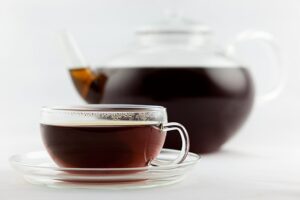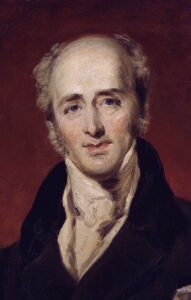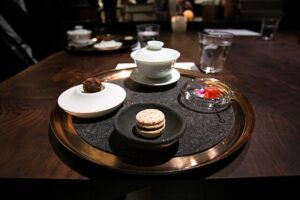The Real History of Earl Grey Tea
Date post added: 15th April 2025
There’s something so very British about a cup of tea. It’s the answer to everything, from getting going in the morning, to breaking bad news, or catching up on the neighbourhood news. “I’ll put the kettle on,” is a Brit’s default setting.
The notion of Brits as tea drinkers is such a strong association. Hundreds of Americans have fallen for a recent online prank which spread the fallacy that a nationwide afternoon tea alarm sounds daily to remind us to stop for a brew or pay the consequences!
We’re not talking English Breakfast Tea here. Oh no, this blog is all about a more sophisticated and fragrant tea blend – Earl Grey Tea. But who on earth was Earl Grey and what did he have to do with our beloved cuppa?
Pour yourself a cup of tea, curl up, and discover the tale of the English aristocrat and Prime Minister that’s still linked to a popular yet distinctive black tea.
What is Earl Grey tea?
If you’ve had a lifelong monogamous relationship with regular ‘builder’s tea’, then you may not be familiar with the more fruity tea – Earl Grey. So what is it exactly?
Earl Grey is a black tea scented with the oil from bergamot orange rind. Not got a bergamot in your fruit bowl? Me neither. But bergamot is a citrus fruit that’s most commonly found in Calabria, Italy and the South of France. Its rind is added to black tea, and that’s what gives Earl Grey tea its citrusy kick.
Traditionally, Earl Grey tea was made from Chinese black tea. But nowadays, it may be blended with oolong, lapsang souchon, or even green tea.
Here’s a funny thing. Earl Grey tea has a reputation for being posh and refined. It has an aristocrat’s name after all. But some say that the reason bergamot oil was added to black tea in the first place was to mask the flavour of low-quality tea leaves.
How did Earl Grey tea get its name?
As with many origin stories, there’s not one absolute answer. There are several tales relating to Earl Grey and his association with a bitter orange tea blend. The aristocrat in question is Charles Grey, the 2nd Earl Grey, who was British Prime Minister from 1830 to 1834.
Tale 1: The heroic rescue
Probably the most popular Earl Grey fable positions him as a lifesaver. Whilst on a trip to China, Charles Grey bravely saved a person from drowning. The person’s father was so grateful to Charles Grey that he presented him with, either the tea itself, or a recipe for black tea scented with the oil of bergamot oranges.
The spanner in the works of this story is that Charles Grey may never have gone to China. And, given that bergamot is native to Italy and France, what was the citrus fruit doing in early 19th century China?
Tale 2: The corporate gift
This theory is a more political tale. Charles Grey was Britain’s Prime Minister in the early 1830s. One of his policies was ending the East India Trading Company’s monopoly on trade between Britain and China. This opened up China for free trade with Europe at a buoyant time for the tea trade. As a thank you for his part in boosting Chinese profits, Earl Grey was gifted the tea blend.
This seems plausible and matches historic timelines. But the questions around bergamot being in China still stand. Some historians suggest that Grey was gifted a Chinese black tea and he spiced it up by adding the citrus fruit himself.
Tale 3: The Northumberland waters
The ancestral seat of Earl Grey was Howick Hall in Northumberland, Northern England. There, the waters had a decidedly mineral taste. Fortunately, Charles Grey had a friend (or possibly a worker) who was a Chinese Mandarin. They blended black tea leaves with bergamot essential oil and created a rather nice cup of tea. Lady Grey is said to have served it frequently at afternoon tea parties in London.
Tale 4: The tea house claim
Another suggestion is that the renowned London tea house, Jacksons of Piccadilly, sourced the tea recipe from Lord Grey in the early 1830s. The Grey family can’t have been business savvy as they never trademarked Earl Grey tea. They simply handed it over to the Jackson family. According to Jacksons of Piccadilly, the original recipe has never left their care.
Twinings, another well-known tea house, claim to have been given the recipe by Lady Grey. They have trademarked the “Lady Grey” brand. But as Earl Grey tea hasn’t been trademarked, lots of tea companies sell their own version.
Tale 5: The one with no Earl at all
What if Charles Grey wasn’t involved in the origins of the Earl Grey blend at all? In 1852, a tea merchant named William Grey (that’s Mr Grey, not Earl Grey) created a tea blend called “Grey’s Tea” or “Grey’s Mixture.”
Given that black tea flavoured with bergamot was first mentioned in 1824, “Earl Grey” might simply have been a posh name given to the tea to push up the price. An upmarket rebrand of sorts.
How do you take your Earl Grey tea?
Earl Grey tea remains a popular choice amongst tea lovers. But today, you can have your zesty cup of tea in all manner of ways. For the authentic experience, you really should use loose leaf tea. After all, tea bags hadn’t been invented back in Charles Grey’s day.
A few Earl Grey tea varieties on offer:
- Lady Grey: combines Earl Grey tea with cornflower and Seville oranges
- Russian Earl Grey: black tea with citrus and lemongrass
- Earl Grey Green/ Earl Green: uses green tea in place of black tea leaves
- Rooibos Earl Grey: with the South African herbal tea instead of black tea
- French Earl Grey: a tea blend with rose petals
- Lavender Earl Grey: you guessed it, Earl Grey tea with French lavender
- Caffeine-free Earl Grey: take your tea without the added buzz.
Time for tea?
Tea lovers rejoice. You can discover more fascinating storms in tea cups on our History of Tea walk. And if you want a biccie to go with it, don’t miss our special Biscuits and Banquets, London Foodies walk. Want to know more about the East India Tea Company? Get the lowdown from a distinguished diplomat on our guided walk.
If you’re making a day of it, look through our recommendations for affordable afternoon tea in London.





